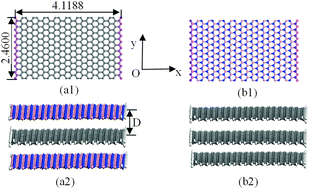Structure stability and high-temperature distortion resistance of trilayer complexes formed from graphenes and boron nitride nanosheets
Abstract
The molecular dynamics was employed to study the structure stability and high-temperature distortion resistance of a trilayer complex formed by a monolayer graphene sandwiched in bilayer boron nitride nanosheets (BN–G–BN) and graphenes (G–G–G). The investigation shows that the optimal interlayer distances are about 0.347 nm for BN–G–BN and 0.341 nm for G–G–G. Analysis and comparison of the binding energy, van der Waals interactions between layers and radial distribution function (RDF) revealed that the BN–G–BN achieves a more stable combined structure than G–G–G. The interlayer graphene in the trilayer complex nanosheets, especially the graphene in BN–G–BN, is more integrated than monolayer graphenes in a crystal structure. The structures at high temperature of 1500 K show that the BN–G–BN exhibits less distortion than G–G–G; especially, fixing the atomic positions on up–down layers can obviously further reduce structural deformation of interlayer graphene. The result further indicates that the high-temperature distortion resistance of interlayer graphene in the trilayer complex is related to both material type and conditions of constraints at the up–down layers.


 Please wait while we load your content...
Please wait while we load your content...